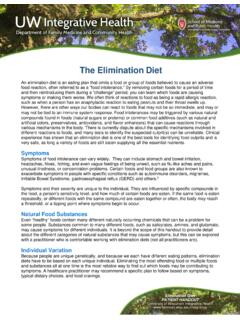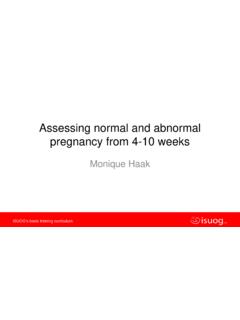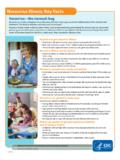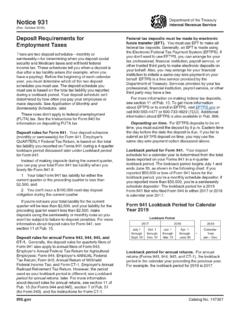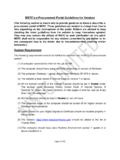Transcription of ASC-161: Feeding and Managing Baby Calves from Birth to 3 ...
1 ASC-161. Feeding and Managing Baby Calves from Birth to 3 Months of Age Donna M. Amaral-Phillips, Patty B. Scharko, John T. Johns, and Sharon Franklin A s the future productive units of a dairy herd, heif- ers represent a substantial financial investment in feed and labor. This investment needs to be protected freshening time, such as preventing retained placentas, and to improve the immune system so that the cow can fight off a disease challenge, such as mastitis infection, just before or by Managing and Feeding these heifers so that they grow after calving. The recommended concentration of selected economically and at an optimal rate in order to calve at minerals and vitamins in the total diet is shown in Table 1. 24 months of age.
2 The first two to three months of life is a In addition, deficiencies of minerals, such as phosphorus, critical period to achieving these objectives. This factsheet manganese, cobalt, copper, zinc, and selenium, can result explains the critical steps in raising Calves during this time in deficiencies in the fetus as well as the newborn calf. period. These steps are important for raising not only dairy Thus, adequate (not excessive) amounts of each mineral heifers but also orphan beef Calves . and vitamin need to be consumed for the health and well- being of both the dam and the unborn calf. Dry Cow Nutrition Program A very effective way to prevent scours in Calves is to Sound Feeding and management programs for young vaccinate the dry cow with a scour vaccine before calv- Calves start with the dam or mother two months prior to ing.
3 Mature cows should be vaccinated four to six weeks calving. The majority of the growth of the calf within the before freshening. Heifers should be vaccinated two dam occurs within the last two months of gestation, and months before calving and boostered again one month the dam provides the nutrients needed for this growth. before freshening. Scour vaccines can include the rota and Also, the management program of the dam affects the corona virus, E. coli, and/or Clostridium perfingens. Indi- quality and amount of antibodies found in her colostrum, vidual farms should consult with their local veterinarian or first milk, which directly impacts the health of the calf to determine the primary cause(s) of calf scours on their after Birth .
4 Farm and for help in selecting the most effective vaccine Dry cows should be fed a diet that is balanced to meet for their situation. their nutrient needs and support the growth of the fetus. If a heifer or cow is slightly underfed energy and/or pro- Table 1. Concentration of selected minerals and vitamins in tein, the fetus will still grow to the same size as if she was the total diet recommended for a 1500-lb Holstein dry cow fed properly, but she will sacrifice her own body reserves from 240 to 280 days pregnant. or growth to support the growth of the fetus inside her. Mineral/Vitamin* Dry matter basis Basically, the growth of the fetus has a higher nutrient Calcium - priority than the growth of the bred heifer or the ability Phosphorus - of a mature cow to maintain her body fat stores.
5 Underfed heifers will have more trouble calving. Older cows will use Magnesium - their body stores of fat and protein, and these stores will Potassium - not be available to support milk production after calving. Copper 12 -18 ppm The important message is that underfeeding dry cows Zinc 21 - 30 ppm and springing heifers does not result in a smaller calf but Selenium ppm instead results in lower performance of the cow or heifer after calving. Vitamin E 1168 - 1211 ppm Adequate minerals and vitamins are important to the *Assumes anionic salts are not being fed the last three weeks dry cow and the calf developing inside her. They are also of gestation. necessary for the dam to minimize health problems around Source: Nutrient Requirements of Dairy Cattle 2001.
6 (7th revised edition). Care of the Calf at Birth Table 2. Typical composition of colostrum (first milking after calv- ing), transition milk (second and third milkings after calving), and As calving time approaches, the cow due to whole milk. calve needs to be watched closely for any compli- cations. Cows and heifers should calve in a clean, Milking after calving dry, grassy lot or a clean, well-bedded pen. Pens Colostrum Transition Milk Whole should be square and should provide 150 to 200 Component 1st 2nd 3rd milk square feet of space; they should have good lighting Total solids (%) and ventilation but be free from drafts. Beef cows Fat (%) can calve outside if a windbreak is available. The newborn calf should begin to breathe short- Protein (%) ly after the umbilical cord breaks.
7 Mucus around Lactose (%) the nostrils should be removed. Do not pound on Calcium (%) the calf's chest or lift it by the rear legs since this Immunoglobulins (%) can do more harm than good. Shortly after Birth , Taken from: Feeding the Newborn Dairy Calf. Special Circular 311. the navel cord should be dipped (not sprayed) with Pennsylvania State University. a 7% tincture of iodine solution. (Do not use teat dip or weaker iodine solutions.). The cow should be allowed to lick the calf ( Feeding 6 pints of colostrum will not cause a Holstein calf after delivery. In cold weather or if the cow does not lick to get scours.) The amount of antibodies absorbed is related the calf, the calf should be dried with clean cloths. This to the timing of colostrum Feeding after Birth .
8 Within six practice not only dries the calf but stimulates the calf's hours after Birth , the ability of the gut to absorb antibodies blood circulation. Generally, dairy Calves are removed decreases by one-third. By 24 hours, the gut can absorb only from their dam shortly after the dam has licked the calf 11% of what it originally could have absorbed at Birth . Also, clean (within one hour). at 24 hours of age, digestive enzymes break down and digest all of the antibodies. Early Colostrum Intake = Survival Oftentimes, farmers let the Colostrum is secreted by the mammary gland shortly calf nurse its dam. Research Calves are born with before and after calving. True colostrum is obtained only has shown that many of these little defense or im- from the first milking.
9 After the first milking and for the Calves do not nurse adequate next two and a half days, the cow's milk is called transi- amounts of colostrum from munity against disease. tion milk. their dams within the first few They acquire resistance Colostrum provides a calf with its primary source of hours of life, and thus they nutrients. As shown in Table 2, true colostrum contains may not receive adequate to disease from their twice as much dry matter and total solids, two to three immunity to fight off dis- dam through timely times as many minerals, and five times as much protein ease. Hand- Feeding newborn as whole milk. Colostrum also contains various hormones Calves is recommended so and adequate intakes of and growth factors that are necessary for growth and de- that a dairy farmer knows velopment of the digestive tract.
10 Colostrum is lower in how much colostrum an in- high-quality colostrum, lactose, thus decreasing the incidence of diarrhea. Milk dividual calf receives. their mother's first milk. obtained after the first milking is inferior in quality to the Colostrum should be very first milking and should not be fed to the newborn calf as thick and creamy. The qual- colostrum milk. ity of colostrum can be de- Calves are born with little defense or immunity against termined using a colostrometer (available through Nasco disease. They acquire resistance to disease from their dam catalog). Superior quality colostrum contains greater than through timely and adequate intakes of high-quality colostrum, 50 mg/ml of immunoglobulins. Before milking the cow, their mother's first milk.

